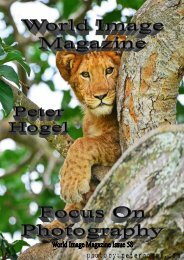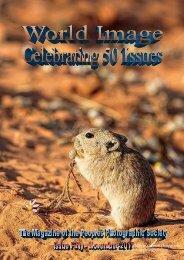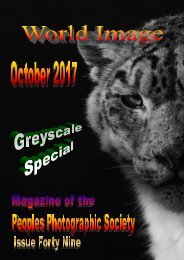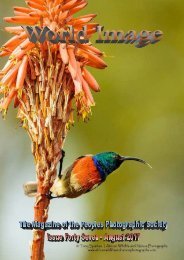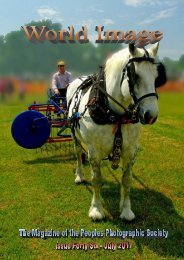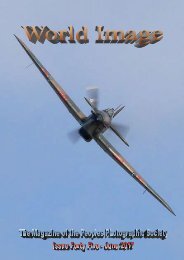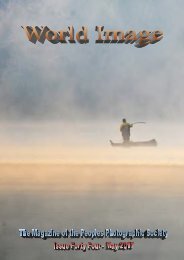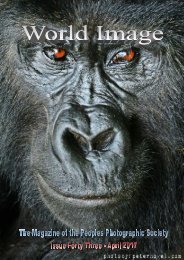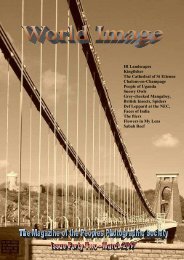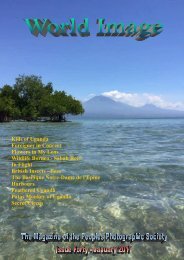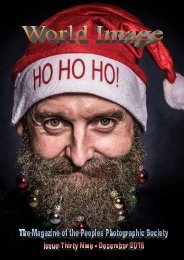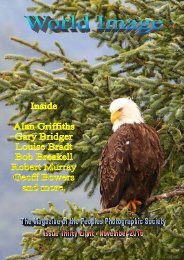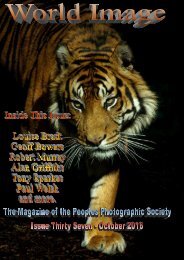World Image Issue 48 September 2017
World Image Issue 48 September 2017
World Image Issue 48 September 2017
Create successful ePaper yourself
Turn your PDF publications into a flip-book with our unique Google optimized e-Paper software.
Website = photosociety.net Page 1 email = magazine@photosociety.net
National and Regional Management<br />
Gordon Longmead - England - CEO<br />
Peter Hogel - Uganda - Deputy CEO<br />
Scott Hurd - Namibia<br />
Tom Coetzee - South Africa<br />
Paul Welch—Australia<br />
Steve Cook - USA<br />
Robert Murray - Scotland<br />
Tina Andreasson - Sweden and Mexico<br />
Jack Glisson - Kentucky USA<br />
Alan Griffiths, England<br />
In This <strong>Issue</strong>:<br />
3 Goldfinch and Willow Tit - Pictures Scott Latham, England<br />
4 Spot Tutorial, Shooting the Rain isn't easy! Scott Hurd, Namibia<br />
6 People of Uganda, Gordon Longmead, England<br />
10 Australia, Gippsland Victoria with Geoff Bowers, England<br />
14 Arkansas with Louise Bradt, USA<br />
16 Sailors Welcome, Sailors Warning with Alan Griffiths, England<br />
18 Birds of a Colour, Peter Hogel, Uganda<br />
19 Nicola Jane Crawford, England<br />
20 British Icons, Gordon Longmead, England<br />
24 The River Nile … Peter Hogel, Uganda<br />
28 Just People ... No, Not Just People, Gordon Longmead, England<br />
32 Wildlife of America - Ducks and Drakes by Larry Hitchins, USA<br />
33 A Study in Nature - Jay, Pictures by Scott Latham, England<br />
34 Brooks Medieval Faire <strong>2017</strong> with Bob Breakell, Canada<br />
36 South Africa with Tony Sparkes<br />
42 Peter Hogel in Uganda<br />
46 Flowers in My Lens, Gordon Longmead, England<br />
50 The Ruin of Ayot St Lawrence<br />
52 Wildlife of America - On The Pond , Larry Hitchins, USA<br />
© Please remember that all articles and images published in this magazine are copyright protected<br />
Cover picture - Ugandan Sunset by Peter Hogel<br />
Website = photosociety.net Page 2 email = magazine@photosociety.net
Website = photosociety.net Page 3 email = magazine@photosociety.net
Shooting the Rain isn't easy!<br />
My Namibian friends will think I'm deliberately teasing them by sharing this at the driest time of the year,<br />
so I'd better start with an apology. You could always practice with a sprinkler. English friends will<br />
understand, they know any time of the year can suddenly turn into the rainy season.<br />
1. Cameras hate rain - so beware! Shoot in the dry.<br />
2. Shutter speed is important. Too slow and the drops all merge together, too fast and all you get are little<br />
dots. Each storm is different and each shot is an experiment. A tripod might prove useful.<br />
3. Aperture needs thought. Do you want to focus on some of the rain or all of it.<br />
4. Usually the light will be low so use the ISO to give you the settings you need.<br />
5. Back-lighting helps make the drops stand out.<br />
6. Reflections and drops hitting puddles makes rain look more realistic.<br />
Have fun! I'd love to see your good ones.<br />
Scott Hurd, Namibia<br />
Website = photosociety.net Page 4 email = magazine@photosociety.net
Cape Glossy Starling - not a rare bird but to get it feeding in such a position with the sun heightening the<br />
colours was magical. The fact that the eye matched so well was a bonus.<br />
Scott Hurd, Namibia<br />
Photography - so<br />
important in so many<br />
professions around the<br />
globe. Here we were<br />
working with anti<br />
poaching units,<br />
teaching them to use<br />
cameras in very low<br />
light situations.<br />
The two photos<br />
demonstrate the use of<br />
flash to fill in the<br />
details against the<br />
sunset, something the<br />
APUs see as a luxury.<br />
Website = photosociety.net Page 5 email = magazine@photosociety.net
Website = photosociety.net Page 6 email = magazine@photosociety.net
Website = photosociety.net Page 7 email = magazine@photosociety.net
Website = photosociety.net Page 8 email = magazine@photosociety.net
Website = photosociety.net Page 9 email = magazine@photosociety.net
Sale Common Wetland Lakes and Reserve, and on 90 Mile Be<br />
Website = photosociety.net Page 10 email = magazine@photosociety.net
Website = photosociety.net Page 11 email = magazine@photosociety.net
Website = photosociety.net Page 12 email = magazine@photosociety.net
Camouflage at it's best...would like to see what you see<br />
in the one specific image<br />
Tom Coetzee<br />
Website = photosociety.net Page 13 email = magazine@photosociety.net
Sometimes I take a couple of hours off to just sit and enjoy the glorious<br />
sunshine we have here in Arkansas and get treated to lots of bird<br />
activity, including Robins, Turkey Vultures & a Juvenile Red-Tail<br />
Hawk<br />
I don't often try and get milky way shots, but last night was an<br />
opportunity too good to miss. Even with the light pollution from the<br />
neighbours and the tree closest to me which is right by the deck I was<br />
shooting from, it was still amazing.<br />
Website = photosociety.net Page 14 email = magazine@photosociety.net
Website = photosociety.net Page 15 email = magazine@photosociety.net
Website = photosociety.net Page 16 email = magazine@photosociety.net
Website = photosociety.net Page 17 email = magazine@photosociety.net
Website = photosociety.net Page 18 email = magazine@photosociety.net
Website = photosociety.net Page 19 email = magazine@photosociety.net
Website = photosociety.net Page 20 email = magazine@photosociety.net
Website = photosociety.net Page 21 email = magazine@photosociety.net
Website = photosociety.net Page 22 email = magazine@photosociety.net
Website = photosociety.net Page 23 email = magazine@photosociety.net
And there she is, The River Nile floating from the<br />
source in Jinjja all the way up to Alexandria in<br />
Egypt stretching almost 7000Km.<br />
First runner up are, no big surprise there, hippos<br />
with literally thousands of hippos, they are<br />
guaranteed to be found yawning to show who’s in<br />
charge, their little tails working it like propellers to<br />
spread their dung, marking territory… lets not get<br />
too close.<br />
Our part of the Nile goes straight through Murchison<br />
NP, and we start our journey down stream and our<br />
goal is the impressive Murchison falls.<br />
On a smaller private boat we have our privacy and<br />
can quietly get closer to the animals along the way<br />
whilst sipping a glass of cool white wine or why not<br />
have a Nile (beer) on the Nile, and some delicious<br />
snacks along the way.<br />
Slowly making our way up the Nile with a nice<br />
breeze cooling us down we pass an abundant of<br />
wildlife, crocodiles sunbathing on the shore.<br />
Website = photosociety.net Page 24 email = magazine@photosociety.net
Families of elephants coming down to drink and<br />
cool of in the water, buffaloes and waterbuck…<br />
We see foam building up on the surface of the water<br />
and the current is picking up, we are getting closer<br />
to the falls, we are passing the landmark where the<br />
famous writer Ernest Hemingway crashed in a<br />
plane, surviving and sometime later crashing again,<br />
surviving again, the black and white Colobus<br />
monkeys sitting in the canopies, and there she is,<br />
Murchison falls.<br />
The birdlife here is amazing the small but oh so<br />
colourful kingfishers, bee-eaters fishing herons and<br />
fish eagles there is no end to it…<br />
Website = photosociety.net Page 25 email = magazine@photosociety.net
The Nile squeezed in to a narrow passage and<br />
falling down in a turbulent mass of water, we stay<br />
for a while, amazed over the force of the tumbling<br />
falls.<br />
This is where we jump of the boat to hike up to the<br />
top of the falls to get a second view and to stand,<br />
just at the rim with the white water furious passing<br />
by below, Watching, from a safe place.<br />
Peter Hogel, Eden Adventures, Uganda<br />
Website = photosociety.net Page 26 email = magazine@photosociety.net
Website = photosociety.net Page 27 email = magazine@photosociety.net
Website = photosociety.net Page 28 email = magazine@photosociety.net
Website = photosociety.net Page 29 email = magazine@photosociety.net
The Photographer Academy is the largest European<br />
photography training company providing the award<br />
winning training to get inspired or instructed every day.<br />
http://thephotographeracademy.com<br />
Website = photosociety.net Page 30 email = magazine@photosociety.net
The Cat Survival Trust was registered as a charity in<br />
1976. The Trust's on-site objective is to promote<br />
education regarding the conservation of wild cats and<br />
their habitat by housing an array of species in natural<br />
enclosures.<br />
Website = photosociety.net Page 31<br />
http://www.catsurvivaltrust.org<br />
email = magazine@photosociety.net
Pink Eared Ducks<br />
Silver Woodduck Pair<br />
Marbled Duck or Marbled Teal<br />
Fulvous Whistling Duck<br />
Mallard Hen<br />
White Winged Wood Duck this is one of our<br />
endangered duck specie is in heavy decline with only a<br />
few scattered left.<br />
Website = photosociety.net Page 32 email = magazine@photosociety.net
Website = photosociety.net Page 33 email = magazine@photosociety.net
Some of the knights that participated in the jousting at the Brooks<br />
Medieval Faire <strong>2017</strong>. This is a sanctioned event for points in<br />
international standings I understand.<br />
Website = photosociety.net Page 34 email = magazine@photosociety.net
Website = photosociety.net Page 35 email = magazine@photosociety.net
A different photographic genera for me with this macro shot<br />
of the Eastern Dotted Border Butterfly (Mylothris agathina).<br />
Captured in the late afternoon in South Africa's Kruger<br />
National Park.<br />
This butterfly normally found in Mozambique, Zimbabwe,<br />
Botswana and Southern and Eastern South Africa.<br />
Fact: One of the major visual differences between butterfies<br />
and moths are the ''antenna'' You will see here this butterfly<br />
has ''clubbed'' antenna on the end where moths often have<br />
comb-like or feathery antennae, or un-clubbed<br />
Website = photosociety.net Page 36 email = magazine@photosociety.net
The Small Orange Acraea (Acraea alalonga) I think, a long-winged Orange Acraea which is restricted to<br />
North Eastern South Africa.<br />
Fact: Currently their are two other species of Orange AcraeaAcraea anacreon (large orange acraea), found in<br />
eastern and southern Africa, Acraea eponina (small orange acraea), widespread in tropical Africa and<br />
adjacent areas<br />
Captured this little chap the common Dwarf<br />
Mongoose (Helogale parvula) on an<br />
afternoon game drive in South Africa's<br />
Kruger National Park. It was part of several<br />
Dwarf Mongoose that were scampering in<br />
and over an old termite mound.<br />
Fact: Dwarf mongooses are territorial, with<br />
each group using an area of approximately 30<br />
-60 hectares (depending on the type of<br />
habitat). They sleep at night in disused<br />
termite mounds<br />
Website = photosociety.net Page 37 email = magazine@photosociety.net
While in the upper reaches of South Africa's<br />
Western Cape, in the Bontebok National Park<br />
which runs parallel with the 'Langeberg'<br />
Mountains I was lucky enough to cath this male<br />
Malachite Sunbird (Nectarina famosa) sampling<br />
some of the many winter Aloe's currently<br />
blooming all over the country. This large sunbird<br />
is found in hilly fynbos (amongst Protea as well<br />
as Aloes) cool montane and coastal scrub and up<br />
to 2,800m in South Africa.<br />
A male Eastern Golden Weaver (Ploceus<br />
subaureus) admires his work after<br />
building his nest between two bull-rushes.<br />
Bonamanzi Game Reserve - KwaZulu-<br />
Natal - South Africa<br />
Fact: The Malachite Sunbird in the Middle East<br />
and South-East Asia is also known as the 'Green<br />
Sugarbird'<br />
One of my favourite places in South Africa is the Kgalagadi<br />
Transfrontier Park for another epic trip know doubt.<br />
Besides the larger mammals, their are many smaller ones<br />
which make the park their home. Here a Brants's Whistling<br />
Rat (Parotomys brantsii) enjoying another snack in the soft,<br />
warm, golden light of late afternoon.<br />
Website = photosociety.net Page 38 email = magazine@photosociety.net
This juvenile Southern Pale Chanting Goshawk<br />
(Melierax canorus) I photographed it earlier in the<br />
year in the Kgalagadi Transfrontier Park in the<br />
Northern Cape, South Africa. The adult however<br />
has grey upper parts with a white rump. The<br />
central tail feathers are black tipped with white and<br />
the outer feathers are barred grey and white.<br />
Southern Pale Chanting Goshawk females usually<br />
mate with a single male. However, a female and<br />
two males may form a trio under certain<br />
conditions.<br />
Fact: South Africa has 2 species of Chanting<br />
Goshawk - Southern Pale Chanting Goshawk<br />
(Melierax canorus) and the Dark Chanting-<br />
Goshawk (Melierax metabates)<br />
Southern Africa has many species of Hornbill (10)<br />
but our most common and photogenic by far is the<br />
Southern Yellow-billed Hornbill (Tockus<br />
leucomelas). I was fascinated by this Hornbill's<br />
feet when I took this shot in South Africa's Kruger<br />
National Park, not noticing it before it reminded me<br />
of human babies foot/sole as it was scratching<br />
itself.<br />
Fact: Once mated female Hornbill's will seal<br />
themselves inside the nest (tree hollow) by<br />
blocking the entry with a wall made from her<br />
droppings and food remains. The male will help by<br />
bringing mud for her to work with. The only<br />
opening left is a vertical slit from the top to the<br />
bottom. The male passes food to her through this<br />
slit with his beak. Her droppings and food remains<br />
are also squeezed out through this slit.<br />
The female will also shed all of her flight and tail<br />
feathers simultaneously and regrow them during<br />
the time she is sealed in the nest with the chicks.<br />
Website = photosociety.net Page 39 email = magazine@photosociety.net
While scouting Muzi 'pan' (body of<br />
Natal, I was fortunate enough<br />
Flamingos (Phoenicopterus minor)<br />
fairly low flight.<br />
Breeding in Africa, with their mai<br />
amongst the caustic waters of Lake<br />
South Africa, is situated at Kamf<br />
p o l l u t i o n a n d t h e e n c<br />
Despite being the most numerous s<br />
as near-threatened due to its de<br />
number of breeding sites,<br />
This rather pensive looking male Greater Kudu (Tragelaphus strepsiceros) was<br />
staring with some intent as he peered from behind a none existent bush... It<br />
was a little bit of a stand off with neither of us moving a muscle while I took a<br />
few shots of him.<br />
Kudu Fact: Their are two species of Kudu in Sub-Saharan Africa the Greater<br />
Kudu (Tragelaphus strepsiceros) of Eastern and Southern Africa and the<br />
Lesser Kudu, Tragelaphus imberbis found solely in Eastern Africa ans is near<br />
threatened.<br />
One of Africa's most dangerous<br />
(Hippopotamus amphibius) This hip<br />
along the St Lucia estuary - KwaZul<br />
Website = photosociety.net Page 40 email = magazine@photosociety.net
It was a waiting game for me to photograph this young male Kalahari Lion<br />
(Panthera leo bleyenberghi) at a watering hole in the Kgalagadi Transfrontier<br />
Park on a recent trip.<br />
Many hours waiting for lions to come and drink at the waterhole finally paid off<br />
when this young male (I heard him long before I saw him) walked out of the<br />
bush, drank in front of me and walked off again. It was all over in a matter of<br />
minutes....<br />
- South Africa<br />
Fact: Wiki advises subspecies of lions, provided by Haas et al. (2005), suggests<br />
that lions in the Kalahari Region are of two subspecies: Panthera leo krugeri<br />
and Panthera leo bleyenberghi.<br />
Website = photosociety.net Page 41 email = magazine@photosociety.net
I'm not grumpy…<br />
Website = photosociety.net Page 42<br />
I just don't like people...<br />
email = magazine@photosociety.net
Website = photosociety.net Page 43 email = magazine@photosociety.net
Leopard in ishasha.<br />
Life in the wild is not always easy, battle for<br />
territory, food, water and females (not<br />
necessarily in that order)... This fellow was<br />
seemingly doing OK, in spite of a severely<br />
ripped off nose and teeth...<br />
Giant Kingfisher showing its true col<br />
Website = photosociety.net Page 44 email = magazine@photosociety.net
Karate learned the side kick from the ancestors of the Giraffe<br />
It rains in Uganda as well.<br />
Elephant making a stand, "go away"... And we did...<br />
Website = photosociety.net Page 45 email = magazine@photosociety.net
Website = photosociety.net Page 46 email = magazine@photosociety.net
Website = photosociety.net Page 47 email = magazine@photosociety.net
Website = photosociety.net Page <strong>48</strong> email = magazine@photosociety.net
Website = photosociety.net Page 49 email = magazine@photosociety.net
Ayot St Lawrence is a small village and civil parish in<br />
Hertfordshire, about three miles from Welwyn. The<br />
villages main claim to fame is that it was the home of<br />
George Bernard Shaw, who resided at what is now<br />
known as Shaw's Corner, from 1906 until his death in<br />
1950.The current village has two churches, the new one<br />
is in a Palladian style which looks more like a folly than<br />
a church, and appears totally out of place in the beautiful<br />
Hertfordshire countryside that surrounds it.<br />
Website = photosociety.net Page 50 email = magazine@photosociety.net
The old one, the subject of this presentation, is located in the<br />
centre of the village, was partially demolished in 1775,<br />
because it was obstructing the view from Sir Lionel Lyde's<br />
new home. So much for the gentries respect of religion and<br />
architecture.<br />
But in rural areas this was the normal behaviour of the gentry.<br />
They owned the land and everyone on it. Laugh at a ‘ladies’<br />
hat and you were flogged, pick up a stick from the side of the<br />
road, or fruit from a roadside bush, and you were charged<br />
with theft. The gentry owned the land so if you transgressed<br />
as an agricultural worker, which most of the population were<br />
(and in tied houses), you were out of a job and home.<br />
So when Sir Lionel decided to construct a new home, rather<br />
than position it differently, he did so in such a way that the<br />
church had to go. It is interesting to note that only part of the<br />
church was removed, the most obvious obstruction, the tower,<br />
still remains.<br />
The Norman nature of the church is still evident in the arches<br />
and layout of the remains, although the tower has become<br />
dangerous and unstable with time.<br />
The fact that the structure was never fully demolished<br />
suggests that his lordships objection was not the obstruction<br />
of the view from his home, but that he did not want the<br />
parishioners walking past in such proximity every Sunday<br />
morning.<br />
I suspect that Sir Lionel may also have had a falling out with<br />
the then incumbent of the church, or perhaps the church itself.<br />
Either way the partial demolition has left us with a good<br />
location for photography that should endure for a while longer<br />
at least. GLL<br />
Website = photosociety.net Page 51 email = magazine@photosociety.net
Eurasian Teal<br />
King Rail<br />
Pintail Drake<br />
Website = photosociety.net Page 52 email = magazine@photosociety.net
Red Billed Pintail<br />
Clapper Rail on the Run<br />
Ringed Teal<br />
Website = photosociety.net Page 53 email = magazine@photosociety.net
Website = photosociety.net Page 54 email = magazine@photosociety.net
Kuyimba means 'to sing' in the Zambian Chinyanja language<br />
and this site is a celebration of the sights and sounds of<br />
southern Africa. Join us to experience it for yourself.<br />
Derek & Sarah Solomon<br />
www.kuyimba.com<br />
Website = photosociety.net Page 55 email = magazine@photosociety.net
Website = photosociety.net Page 56 email = magazine@photosociety.net




